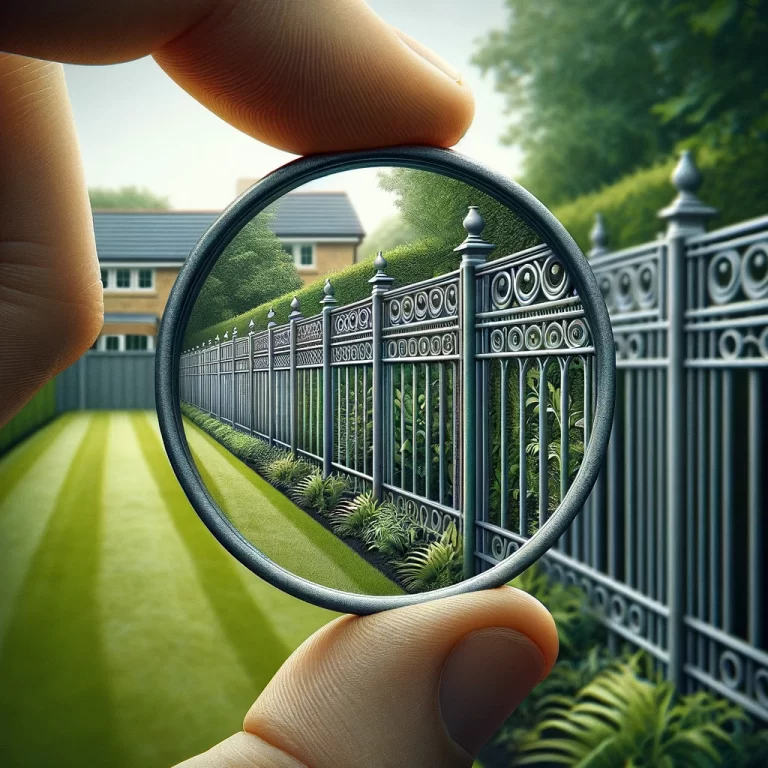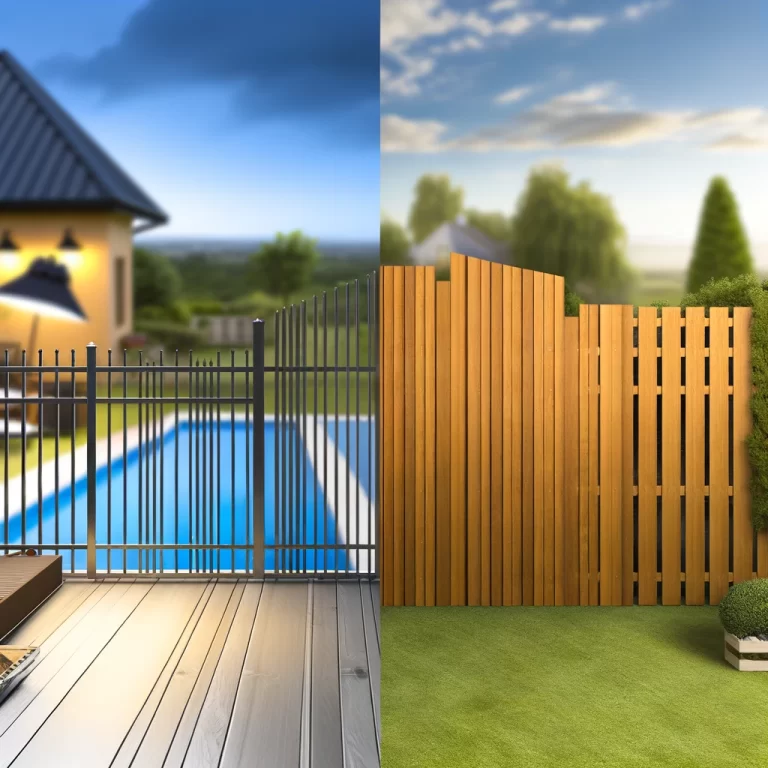Are you a dog owner looking to create a safe and secure space for your furry friend to play and roam freely? Choosing the right fence for your dog is crucial to their safety and well-being. In this article, we will explore the different types of fences available, including chain link, wooden, vinyl, electric, and invisible fences. We will also discuss important factors to consider when selecting a fence for your dog, such as their size and breed, escape tendencies, budget, and aesthetic preferences. We will provide tips on training your dog to stay within the fence and the benefits and drawbacks of having a fence for dogs. So, if you want to learn more about how to maintain a dog fence and ensure your pup’s happiness and security, keep reading!

What Is The Best Fence For Dogs?
Choosing the best fence for dogs is a crucial decision for pet parents looking to provide a safe and secure environment for their furry companions.
When selecting a fence, it’s essential to consider various factors to ensure it meets your dog’s specific needs. For instance, for smaller breeds or elderly dogs, a fence with minimal gaps might be ideal to prevent them from squeezing through or getting stuck. On the other hand, high-energy or larger breeds may require taller and sturdier fences to contain their jumping or digging tendencies.
- Ready-made fences offer convenience and come in various styles like chain-link, vinyl, or wooden fences. They are relatively easy to install and can provide a quick solution for pet owners in need of a secure enclosure.
What Are The Different Types Of Fences For Dogs?
Dog owners have various options when it comes to choosing fences for their pets, such as wooden, chain link, metal, invisible, and GPS dog fences.
Chain Link Fences
Chain link fences are a popular choice for dog owners due to their durability and affordability, providing a secure boundary for pets to roam freely.
One of the key advantages of chain link fences is their visibility, allowing pet owners to keep an eye on their pets while they play in the yard. They are easy to install and require minimal maintenance, making them a practical option for busy households.
Some drawbacks include the lack of privacy they offer, as curious dogs may be tempted to interact with passersby. It’s important to consider the size and breed of your dog when opting for a chain link fence, as smaller breeds or those that are adept at jumping may require additional measures to prevent escape.
Wooden Fences
Wooden fences offer a classic and aesthetically pleasing option for dog owners, blending well with different landscaping styles while providing a sturdy barrier for pets.
When considering wooden dog fences, there are several design options to choose from, ranging from traditional picket fences to more modern horizontal slat designs. The customisation possibilities are vast, allowing pet owners to tailor the fence to their specific needs and preferences.
Maintenance plays a crucial role in the longevity of wooden fences, requiring occasional staining or sealing to protect the wood from rot and decay. Weather resistance is another essential factor to consider, with some wood species naturally more durable against outdoor elements than others.
Vinyl Fences
Vinyl fences are a low-maintenance alternative for dog owners, offering durability and resistance to elements while providing a visually appealing boundary for pets.
One of the key benefits of vinyl fencing for dogs is its longevity; these fences can withstand inclement weather conditions, making them ideal for outdoor use. Their smooth surfaces make cleaning a breeze, requiring only a simple wash with water to maintain their pristine appearance.
Vinyl fencing also offers excellent customisation options, allowing dog owners to choose different heights, styles, and colours to suit their specific needs and preferences. This versatility makes it easy to accommodate various dog breeds and sizes, ensuring that your furry friend stays safe and secure within the confines of your property.
Electric Fences
Electric fences provide a practical solution for pet owners looking to establish boundaries without obstructing views, offering options like underground and wireless systems.
Underground electric fences work by burying a wire a few inches underground to create an invisible boundary. When the dog approaches the perimeter, the collar emits a warning sound followed by a mild static correction if they continue. On the other hand, wireless electric fences use a central transmitter to create a circular boundary around the house, triggering a warning tone and correction on the collar as the dog approaches the limit.
When considering the best choice for your furry friend, it is important to take into account the breed and size of the dog. While underground systems are suitable for most breeds, wireless systems are more convenient for smaller dogs or situations where burying a wire may be impractical.
Invisible Fences
Invisible fences utilise cutting-edge technology to create virtual smart barriers that keep dogs within designated areas, offering a seamless and effective containment solution.
These modern solutions to pet containment are highly effective in training dogs to understand their boundaries without physical barriers, using a system of underground wires and a receiver collar that emits a warning tone or correction if they cross the boundary limits. Training is crucial for their success, ensuring that dogs learn the boundaries and stay safe within the area.
Invisible fences are versatile and can be adapted to different dog breeds and sizes, providing a customisable containment solution for households with multiple pets of various sizes.
Before installing an invisible fence, it is essential to check local regulations and neighbourhood guidelines, as some areas may have specific rules or restrictions regarding their use.

What Are The Factors To Consider When Choosing A Fence For Dogs?
Several factors should be taken into account when selecting a fence for dogs, including the pet’s age, size, breed, activity level, and jumping capabilities.
For instance, the age of the dog plays a significant role in determining the height of the fence; puppies may require a fence with smaller gaps to prevent them from squeezing through, while older dogs may need sturdier materials for containment.
Size and breed also contribute to the type of fence needed; larger breeds may require taller fences to prevent them from jumping over, while smaller dogs might be contained with lower fences. Understanding the activity level of the dog is crucial in selecting the right materials; energetic dogs may need fences resistant to chewing and digging, while calmer dogs may suffice with standard fencing options.
Size And Breed Of Dog
The size and breed of a dog play a significant role in determining the appropriate height and strength requirements of the fence to ensure the pet’s safety and containment.
For example, larger breeds or highly energetic dogs like Huskies or Greyhounds require taller fences, typically at least 6 feet high, to prevent them from jumping over. On the other hand, small breeds such as Chihuahuas may be easily contained by shorter fences, around 3-4 feet high.
Considering the activity level of the dog is crucial in selecting fencing materials. Active breeds like Border Collies may need fences with sturdy materials like vinyl or chain-link to prevent them from breaking through, while calmer breeds like Bulldogs may be fine with wooden fences.
Escape Artists
Dogs known as escape artists require specialised fencing solutions, such as modifying existing fences, installing coyote rollers, or utilising products like Dog Proofer and Pet Playgrounds.
Escape-prone dogs can present unique challenges for pet owners, as they are often determined and skilful in finding ways to get out of traditional enclosures. Modifying existing fences with extenders or barriers that prevent digging or jumping can be effective. Installing coyote rollers on top of fences can discourage climbing attempts. Products like Dog Proofer, which create inward-facing extensions at the top of the fence, and Pet Playgrounds, with dig-proof barriers, offer innovative solutions for enhanced containment and security.
Budget
Setting a budget is essential when choosing a dog fence, as it helps in narrowing down options and finding a solution that balances cost-effectiveness with quality.
When considering different budget ranges for dog fences, it’s crucial to factor in the cost variations based on materials and installation methods.
Wooden fences are traditionally charming and sturdy but may require more maintenance over time, potentially impacting long-term costs.
Vinyl fences offer a low-maintenance option, though they might come at a higher initial cost.
For those looking for a balance between cost and durability, chain-link fences present a more budget-friendly alternative, especially for larger areas.
Aesthetic Appeal
Beyond functionality, the aesthetic appeal of a dog fence is crucial for integrating seamlessly into the landscape, with options such as brick, stone, and plastic fences offering diverse design choices.
- Brick fences exude a classic charm, adding a timeless elegance to any outdoor space, while stone fences create a rustic and natural look, blending effortlessly with gardens or wooded areas.
- On the other hand, plastic fences are versatile and low-maintenance, ideal for contemporary landscapes seeking a clean and modern aesthetic. Each material choice comes with its own set of considerations, from durability and weather resistance to color options and installation requirements.
- When selecting a fencing material, it is essential to consider the overall design theme of the landscape, ensuring that the fence complements existing features such as hardscaping elements, plants, and outdoor furniture.
How To Train A Dog To Stay Within The Fence?
Training a dog to stay within the fence requires a combination of positive reinforcement, consistent guidance, and vigilant supervision to reinforce the boundaries effectively.
Positive reinforcement involves rewarding your furry friend for staying within the designated area, whether through treats, praise, or favorite toys. By associating positive experiences with staying inside the fence, your dog will be more likely to obey this boundary.
Consistency is key in reinforcing these boundaries; make sure to set clear expectations and stick to them. Dogs thrive on routine, so maintaining a consistent approach will help them understand what is expected of them.
Supervision plays a crucial role during the training process. It allows you to intervene immediately if your dog attempts to cross the boundary, reinforcing the consequences of disobedience. Regular supervision also provides opportunities to praise and reward good behavior, further solidifying the desired boundaries.
Positive Reinforcement
Positive reinforcement techniques, such as rewards and praise, are instrumental in teaching dogs to associate staying within the fence with positive experiences.
One effective strategy is the use of treats to reward the dog when they remain within the boundaries. By providing a tasty treat immediately after the desired behaviour, the dog links staying inside the fence with receiving a delicious prize. Incorporating toys can make the learning process more engaging and fun for the dog. Interactive toys or special play sessions after successful boundary compliance can further reinforce the desired behaviour.
Consistencia
Consistency in enforcing boundaries is crucial for reinforcing the training and ensuring that the dog understands the limitations and expectations within the designated area.
In terms of training your dog, one of the key factors that can make or break the process is consistency. Dogs thrive on routine and structure, so having consistent boundaries in place helps them understand what is expected of them. By maintaining a uniform approach to rules and consequences, you eliminate any confusion that may arise from mixed signals.
Consistency in training protocols also helps in establishing a clear communication channel between you and your dog. When the rules are applied consistently, your furry friend learns to respect the boundaries set for them, making it easier for them to stay within the designated area.
Supervisión
Regular supervision during the initial training phases helps in correcting any boundary breaches promptly, allowing for immediate redirection and reinforcement of desired behaviours.
Effective monitoring involves remaining alert to identify warning signs of potential boundary breaches, such as pacing, whining, or attempts to dig under the fence. By observation, supervisors can intervene before the dog actually escapes.
It is essential to establish clear boundaries and consistently enforce the training guidelines to instil the understanding of staying within the designated area. Praising and rewarding the dog for exhibiting appropriate behaviour inside the fence reinforces the training positively.
What Are The Benefits Of Having A Fence For Dogs?
Installing a fence for dogs offers numerous benefits, including enhanced safety, increased freedom to roam, and the ability to integrate tracking technologies like dog GPS trackers for added security.
Having a dedicated dog fence gives pet owners peace of mind that their furry companions are safe within the designated boundaries. It helps prevent escapes, reducing the risk of accidents or getting lost. With the freedom to roam around a secure area, dogs can get their exercise and playtime without the worry of straying too far.
The incorporation of advanced tracking devices, such as dog GPS trackers, allows owners to monitor their pets’ movements in real-time. This technology enables quick location tracking in case of emergencies or if a pet goes missing, enhancing overall safety and protection.
What Are The Disadvantages Of Having A Fence For Dogs?
Whilst dog fences provide security, they also come with certain drawbacks, such as the limitations of DIY installations and constraints associated with specific fence types.
One of the challenges of DIY dog fence installations is ensuring proper setup and maintenance, which can be tricky for those without prior experience.
Traditional fence types, such as wooden or chain-link fences, may present limitations in terms of visibility and flexibility, potentially obstructing the view and restricting movement for both the dog and the owner.
To overcome these disadvantages, technological advancements have led to the development of modern electronic dog fences, offering invisible boundaries and customisable settings to suit individual needs and preferences.
How To Maintain A Dog Fence?
Proper maintenance is essential to ensure the longevity and effectiveness of a dog fence, involving regular inspections, repairs, and professional assistance from companies like Ergeon.
Regular inspections play a crucial role in identifying any potential issues early on, such as loose wires or malfunctioning components. By conducting routine checks, unwanted surprises can be minimized, ensuring that your furry friend stays safe within the perimeter.
In terms of repairs, it’s important to address any damages promptly. Whether it’s fixing a broken wire or replacing a damaged post, attending to these repairs promptly can prevent further deterioration and maintain the integrity of the fence.
While DIY repairs are possible for minor issues, seeking professional help from companies specialising in dog fence maintenance, like Ergeon, can provide expert solutions and ensure that your fence remains in top condition for years to come.






